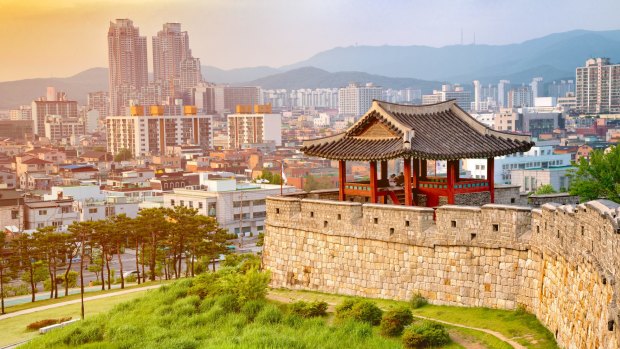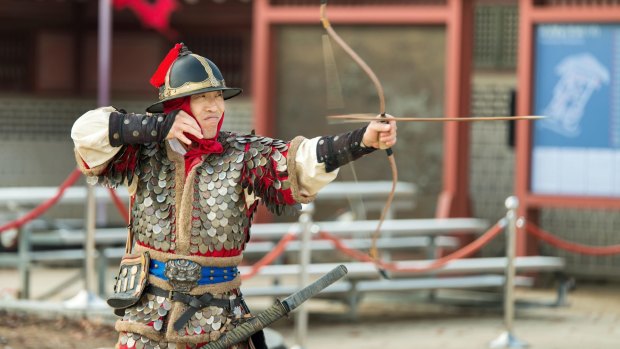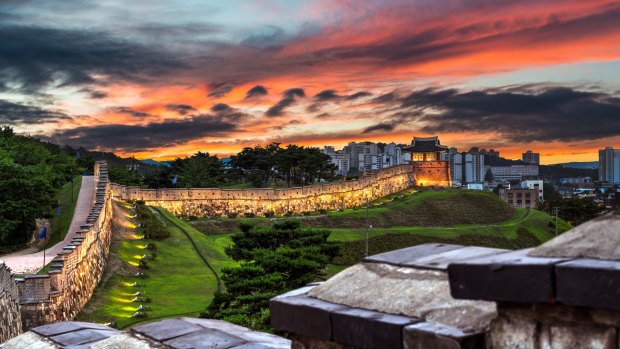This was published 1 year ago
Suwon, South Korea: Impressive fortress is like a mini Great Wall

Suwon was founded as Korea's first planned city in the 18th century, and its crowning glory is Hwaseong Fortress, now a World Heritage site.Credit: iStock
A train wafts me gently south from Seoul. It barely makes a noise, and passengers sit peacefully plugged into iPods. Beyond the windows, skyscrapers give way to apartment blocks festooned with laundry. A green smear of countryside appears and is quickly gone as we draw into Suwon station.
Suwon is practically a Seoul suburb, but this rewarding small-town destination makes an effort to distinguish itself from its big-city neighbour. It's well-known for nightlife, an outstanding soccer stadium and Korea's largest amusement park.
I'm not here for nightclubs or rollercoasters, though, but for a ramble through history. Suwon was founded as Korea's first planned city in the 18th century, and its crowning glory is Hwaseong Fortress, now a World Heritage site.

Suwon Hwaseong Cultural Festival in October demonstrates fighting methods from Hwaseong's heyday.Credit: Alamy
Hwaseong isn't some sombre military relic or antique-choked castle you shuffle around with a tour guide. It's a series of battlements that resemble a Great Wall of China in miniature, running six kilometres up and down hills and enclosing an old town and pine-scented forest. Before long, I'm tramping from one gaudy pavilion to another, admiring pink azaleas and views over town.
Tracks are easy to follow, with signboard maps and explanations in eccentric English. Most of the walking is moderate, but on occasion fortifications rise steeply up hillsides, making me earn my views. Not long after entering the fortress' southern gate, I puff up Mt Paldal to find Koreans on the summit ringing a Bell of Filial Piety and saying prays for their families.
Suwon's founding King Jeongyo is greatly admired for his filial piety, a tradition still highly regarded in this deeply Confucian country. In other ways, the king was a reformer who favoured technological and scientific advancement and presided over a Korean Renaissance. Hwaseong Fortress, completed in 1796, displays cutting-edge military architecture and blends Chinese, Japanese and Korean influences.

Hwaseong Fortress resembles a Great Wall of China in miniature, running six kilometres up and down hills and enclosing an old town and pine-scented forest. Credit: Getty Images
The intimidating external appearance is softened by whimsical pavilions sporting elegant upturned eaves. One is fronted by a pretty humped-back bridge over a tinkling stream. Below the walls, parks erupt with flowerbeds and cherry trees, where locals crunch up spun toffee and buy snacks.
I indulge in a pancake stuffed with shredded pork and beansprouts from a street stand, but still make room for lunch. Suwon is famous for its beef ribs or galbi, which you cook yourself at the restaurant table, and eat accompanied by side dishes of kimchi made from pickled cabbage, cucumber and radish.
I'm here at the wrong time to see the Suwon Hwaseong Cultural Festival in October, which demonstrates fighting methods from Hwaseong's heyday, such as weapon-less martial arts and fencing. After lunch, however, I hop on the free shuttle from the tourist information office and head to Suwon's other great historical drawcard, the Korean Folk Village, where there are re-enactments aplenty.
The Folk Village sits on a forested hillside above the river 30 minutes out of town. I'm a bit of a sucker for open-air museums and this one is excellent, bringing together old buildings from across the country, including temples, a nobleman's residence, farmhouses, a Confucian school and thatched cottages.
The architecture is brought to life by craftspeople in traditional dress, demonstrating how to make bamboo baskets, paper umbrellas and beautiful paper embedded with flower petals. I poke at strange-looking vegetables in the marketplace, admire a ceramic worker who spins a plate with apparent ease, and watch dragons conjured out of toffee by a Dumbledore lookalike with a long, white beard. I might be only an hour from Seoul, but it feels as if I've stepped back centuries.
TRIP NOTES
FLY
Asiana Airlines flies daily between Sydney and Seoul, with domestic codeshare connections on Qantas. See asiana.com
STAY
Novotel Ambassador Suwon sits above Suwon's train station and shopping plaza and has all the mod cons you'd expect of the mid-range Novotel brand. Rooms from $149 per night. Phone 02 9377 8444, see novotel.com
VISIT
Hwaseong Fortress is open daily and costs 1000 won ($1.25), surely a record for a World Heritage site. Various combined tickets cover other Suwon sights and experiences. See swcf.or.kr
MORE
Brian Johnston travelled at his own expense.
Sign up for the Traveller Deals newsletter
Get exclusive travel deals delivered straight to your inbox. Sign up now.